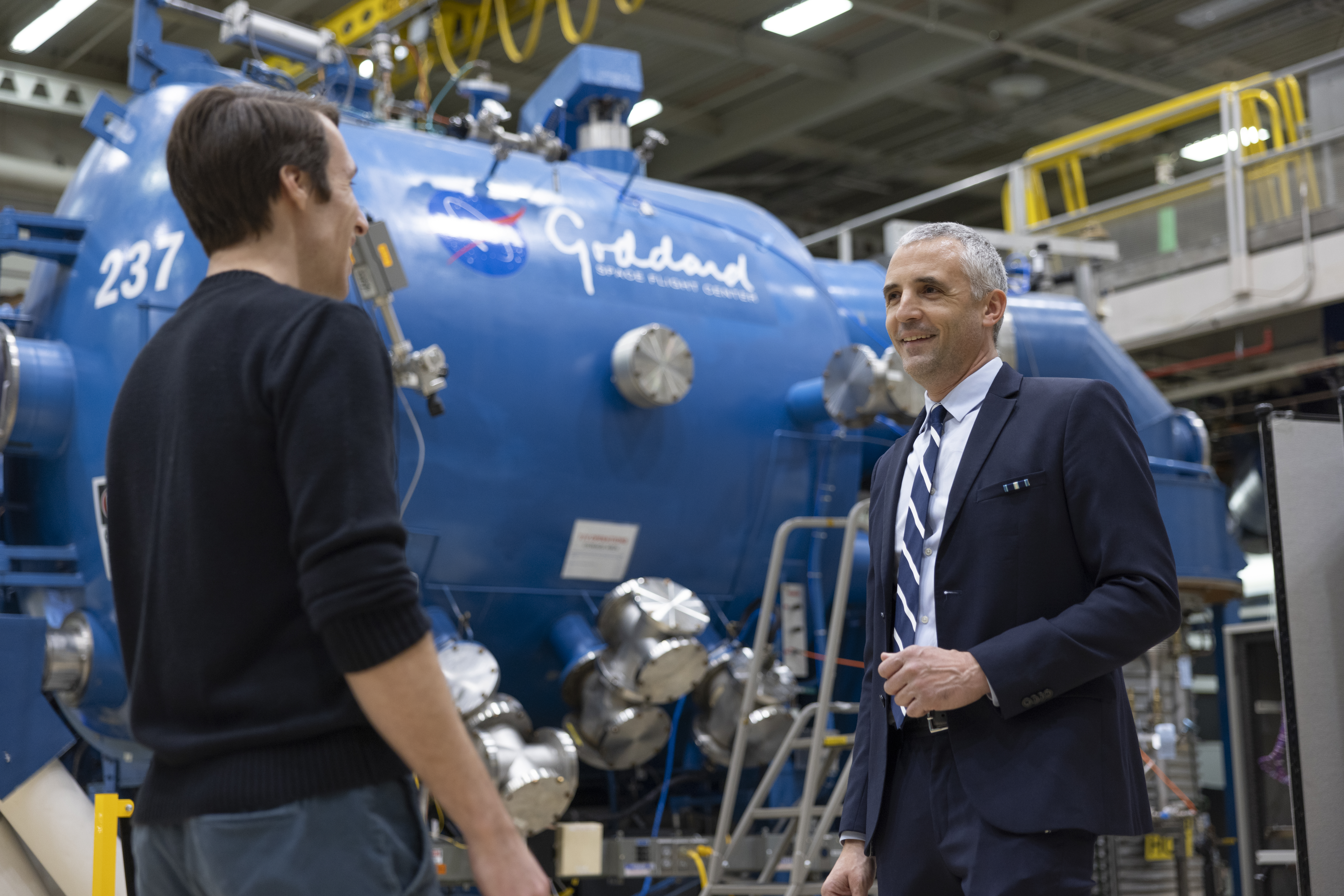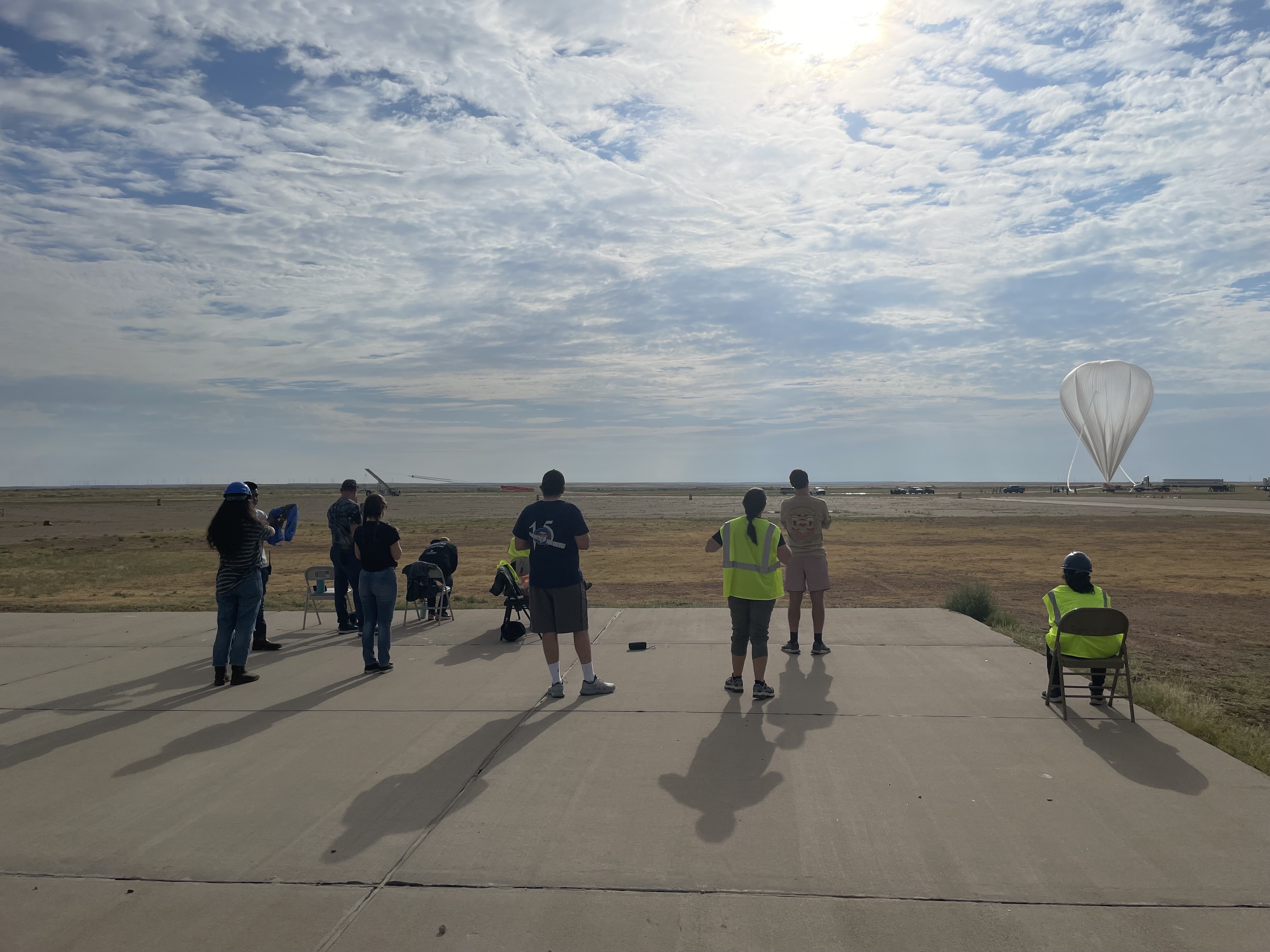Nick Kirschner woke up in the New Mexico desert shortly before midnight and wondered if today was finally the day.
Was it launch day?
It was summer 2023. Kirschner, a fifth-year physics Ph.D. student at George Washington University’s Columbian College of Arts and Sciences (CCAS), was part of a team of NASA scientists that had spent more than a month camped under the wide sky and blazing southwestern sun. They were waiting for the winds to shift and the weather to clear—and a thumbs-up signal that their mission was a go.
For three years, Kirschner, a research astrophysicist at NASA’s Goddard Space Flight Center, had been preparing to send a football field-size balloon carrying high-tech instruments into the atmosphere.
If the plans worked out—if gusts didn’t blow the balloon toward a nearby small town, if thunderstorms or fog didn’t obscure the sky—the mission could be an important early step in developing technologies to map gamma-ray bursts and potentially explore cosmic objects like supernova remnants and massive black holes.
But if the launch was scrubbed—like seven others since Kirschner arrived in the desert—the team would have to wait days or weeks to try again.
“We can have all this technology, we can do all this work,” Kirschner said. “But we’re basically at the mercy of the weather.”
The project is called ComPair, a prototype mission that may lay the groundwork for exploring gamma rays in an uncharted range. It involves dozens of NASA scientists and researchers from labs and universities across the country, including GW.
And it’s also the next phase in a deepening relationship between NASA and the GW Astrophysics Group. In 2021, GW and NASA formalized a milestone partnership with the Space Act Agreement, a pact that promotes university faculty and student research at Goddard. It’s opened the door to new exchanges of expertise on high-level astrophysics missions like ComPair.
“The Space Act agreement is a commitment between NASA and GW to pursue the same goal, which is research and education,” said CCAS Associate Professor of Astrophysics Sylvain Guiriec, an astrophysicist at Goddard and the director of the Space Act Agreement. “At Goddard, [our students] are developing missions and technology, building and launching instruments and analyzing and interpreting data. They have access to scientists from everywhere in the world.”
“The sweet spot”
Kirschner’s journey from NASA lab to New Mexico launch site began in GW classrooms. Mentors like Guiriec piqued his research curiosity—particularly in high-energy astrophysics and gamma-ray burst science. Rather than dreaming of being an astronaut, the Philadelphia-native realized he preferred building telescopes and technologies. “I enjoy instrumentation more than analysis,” Kirschner said. “There are days I spend in the lab just screwing things in, connecting electronics, running tests—building things.”
At Goddard, Kirschner joined a roster of GW students leading cutting-edge projects through the Space Act Agreement. Ph.D. student Roman Kosarzycki, M.S. ’22, for example, is part of a NASA partnership with the Japan Aerospace Exploration Agency to develop an X-ray space telescope. And Alyson Joens, Ph.D. ’23, is the calibration lead for BurstCube, a shoebox-sized satellite that recently launched from NASA’s Kennedy Space Center to the International Space Station.
“The GW partnership with NASA is a huge benefit for us,” said Carolyn Kierans, a Goddard astrophysicist and principal investigator for ComPair. “It allows us access to amazing students. And it’s a great training ground for the next generation of scientists.”
The ComPair project aims, among other goals, to bridge a data gap in gamma-ray astrophysics. Gamma-ray bursts result from some of the universe’s most explosive events, including the birth of black holes and collisions between neutron stars. While they can’t penetrate the Earth’s atmosphere, orbiting instruments like NASA’s Fermi Gamma-Ray Space Telescope can detect gamma rays at low and high energy ranges.
But that leaves a middle range—what Kirschner calls “the sweet spot”—largely unexplored by current technology.
“There’s interesting physics in that gap,” Kirschner explained. “If we don’t have sensitive enough instruments, we can’t get the full picture of what’s happening out there.”
At Goddard, Kirschner built a tracker as part of a larger ComPair instrument to cover that missing middle range. He split his time between his office computer and his lab equipment, calibrating data and fitting 10 layers of silicon detectors into a two-foot-tall box. In a large thermal vacuum chamber, he tested the tracker under simulated real-world flight conditions and prepared for the launch.
The stakes were high, Kierans explained. If successful, ComPair could lay the foundation for the future of gamma-ray research. “We’re trying to prove to ourselves, to the [astrophysics] community and to NASA that this new technology can work on a much larger scale,” she said.
Launch day
In New Mexico, the ComPair researchers set up camp outside the small town of Fort Sumner, with a population under 1,000 and a history as the spot where Billy the Kid was shot and killed. The team unpacked, reassembled and recalibrated their instruments—and waited.
Each day, they met with meteorologists to map out potential launch windows. If conditions looked promising, they’d start their preparations around midnight.
An ultra-thin helium balloon—Kirschner described it as a “giant plastic shopping bag”—would carry a payload of scientific instruments on a gondola. Throughout the night, NASA’s Columbia Scientific Balloon team floated small test balloons into the sky to monitor the unpredictable winds. At dawn, after nearly 40 days at the desert site, the mission finally launched.
For two hours, the team watched the balloon rise to 133,000 feet—four times the cruising altitude of a commercial airliner. It floated for three hours as Kirschner’s tracker collected data, before internal explosives in the balloon were detonated and the gondola parachuted to the ground.
While it may take more than a year to analyze the ComPair results, the early signs have been promising. “The ComPair flight was a huge success,” Kierans said. “All of the instruments were operating successfully, and the data that we got looks absolutely beautiful.” Plans for a second ComPair mission are already underway.
Meanwhile, GW is already seeing the benefits of the NASA partnership, Guiriec said, as the pact attracts students to the department. “Being highly involved in the development of future instruments is a strategic key for our students as well as for the long-term sustainability of the GW Astrophysics Group’s activities,” he said.
For Kirschner, ComPair has been an invaluable opportunity to hone his skills on a real-world mission while working side-by-side with top astrophysicists—through long hours in the lab and long weeks in the field.
“The coolest part was seeing how all the necessary steps developed from day one to the very last day,” he said, “from putting instruments together to seeing it literally get off the ground.”




